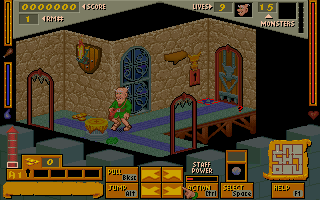 In the early 90s, Apogee had a nice little market. They’d take a popular console game, hack together a PC clone, and distribute it via the then-popular “shareware” model (episode 1 on the house, episodes 2 and 3 available through BBS and mail order). They made simple games that were FUN, something not every game remembers these days between their 200 page design documents and procedurally generated worlds and Hollywood voice talent.
In the early 90s, Apogee had a nice little market. They’d take a popular console game, hack together a PC clone, and distribute it via the then-popular “shareware” model (episode 1 on the house, episodes 2 and 3 available through BBS and mail order). They made simple games that were FUN, something not every game remembers these days between their 200 page design documents and procedurally generated worlds and Hollywood voice talent.
Now and then, though, they released titles that were a bit different. Take Mystic Towers…how would you sell this game?
Most Apogee titles are child friendly. This game has portraits on the walls of naked pin-up girls, and you play an elderly man who scratches his balls from time to time. It’s not an adult game, like Leisure Suit Larry, but you can hear the whisper of an envelope being pushed.
Additionally, the game is not terribly fussed about sticking to a style and at various moments plays like an RPG, a dungeon crawler, a shooting game, a puzzle game, and a platform game. Combining RPG and action gaming became a pretty trendy thing when that say-Devil-in-Spanish game came out but Mystic Towers is a bit different, more redolent of a real pen and paper RPG rather than a stat-grinding action game.
You must enter a series of towers, destroy all the monsters, destroy the monster generator that is spawning the monsters, and find the large red tower key that allows you to leave. You have lots of abilities at your disposal. Your wizard can drag boxes around to make a stack and reach high-up places, use powerups to fly or become invisible, and collect coins with which he can buy weapons. It’s all pretty simple, there’s no stats or classes. Beating the game requires exploration, patience, and a Rain Man-esque ability to memorize floor layouts.
Graphics are impressive by shareware standards. The game uses an isometric perspective for that classy pseudo-3D look. Sprites in Mystic Towers are drawn so that they look like they have depth and exist in real space. There’s some basic environmental interaction, such as dragging a statue backwards to uncover gold coins, and flipping light switches to illuminate rooms. (Why do medieval towers have 20th century light switches? Because they’re mystic towers, reprobate.)
The game is cool and original, but not perfect. I hate the obsessive exploring and item collecting, I hate how the player must go around and around in ever increasing circles. To unlock a door on floor 3 you need a key on floor 2 that is protected by a force field with a switch on floor 5 which is guarded by a monster that can be beaten with a weapon on floor 1…Mystic Towers depends heavily on “whoops, you triggered a trap” level design and this also gets old fast. There are hidden bombs that drop on your head, invisible tiles that poison you, and other annoying things that can’t be anticipated.
The controls are a bit too mystic for my blood. You can only move in four directions, so sometimes you need to walk an awkward zigzag path to get to a destination. Basic movements (such as stepping to the side) aren’t allowed. Fighting monsters is often difficult due to the control scheme, although unfortunately not for any legitimate reason. Killing monsters involves lining yourself up to one and blasting the Ctrl key until it dies.
Playing Mystic Towers is like watching a movie where the director was sacked halfway through production and replaced by someone with completely different ideas. It’s confused and confusing, and a showcase of good ideas in a merely acceptable game.
No Comments »
Comments are moderated and may take up to 24 hours to appear.
No comments yet.
